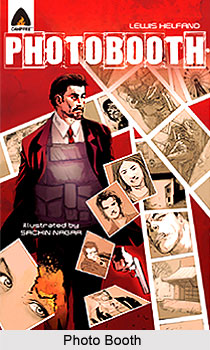 Photo Booth is an Indian graphic novel published and distributed by Campfire Graphic Novels in November 2010. The 80 Pages partly black and white and partly colour graphic novel is written by Lewis Helfand and illustrated by Sachin Nagar and has been edited by Aditi Ray and others. Photo Booth is a sharp thriller about Praveer Rajani, an out of control Interpol agent who tries to prevent murders through mysterious photographs. The story is illustrated with gritty and stark images and the artist has used 2 distinct styles, one is a sketchy, ink-strewn black-and-white style and the other is a more vibrant and coulurful representation of the thrilling plot.
Photo Booth is an Indian graphic novel published and distributed by Campfire Graphic Novels in November 2010. The 80 Pages partly black and white and partly colour graphic novel is written by Lewis Helfand and illustrated by Sachin Nagar and has been edited by Aditi Ray and others. Photo Booth is a sharp thriller about Praveer Rajani, an out of control Interpol agent who tries to prevent murders through mysterious photographs. The story is illustrated with gritty and stark images and the artist has used 2 distinct styles, one is a sketchy, ink-strewn black-and-white style and the other is a more vibrant and coulurful representation of the thrilling plot.
Concept of Photo Booth
The concept of the graphic novel Photo Booth initiated with the idea of an Indian romance story based in New York. The story is set in 2 different time zones, one plot is set in the year 2010 and the other plot is set in 1990 and is revealed through a series of flashbacks. The style of narrative is inspired from the Hindu epic the Mahabharata. The opening segment of the graphic novel focuses on Interpol agent Praveer Rajani investigating a new deadly drug overflowing in the streets of New York City. The authorities have no clue on who is creating the drug or from where it is sourced. Praveer realizes that the only option for preventing innumerable deaths is through a few unexplained photographs. The photographs reveal images of locations to him that many have forgotten long ago. Some of the photos are even related to his brother Jayendra and sister Nisha. Praveer desperately tries to use the links in these photographs to solve a murder case.
There are several sequences in Photo Booth that depict visual symbols which are related with the Upanishads which are sacred philosophical texts believed to be the early source of Hindu religion. The graphic novel often concentrates on important aspects of Hinduism, like the concept of Dharma. The dual stories focus on the central character Praveer Rajani`s Dharma (religion) with respect to his devotion and determination to his family and career. The concept of Ahimsa (Non-violence) is also focused upon in the plot of Photo Booth. The rest of the plot revolves around Praveer`s commitment to his family and a burning desire for vengeance that almost took his life. Even though Praveer Rajani is engulfed with rage and aggression, he stays adamant about following the principles of Ahimsa while solving a problem from his past.
The narrative is presented in such manner that the reader is informed about the concerns of the protagonist Praveer Rajani and the fact that he feels lost and ponders whether he chose the right path in life.



















